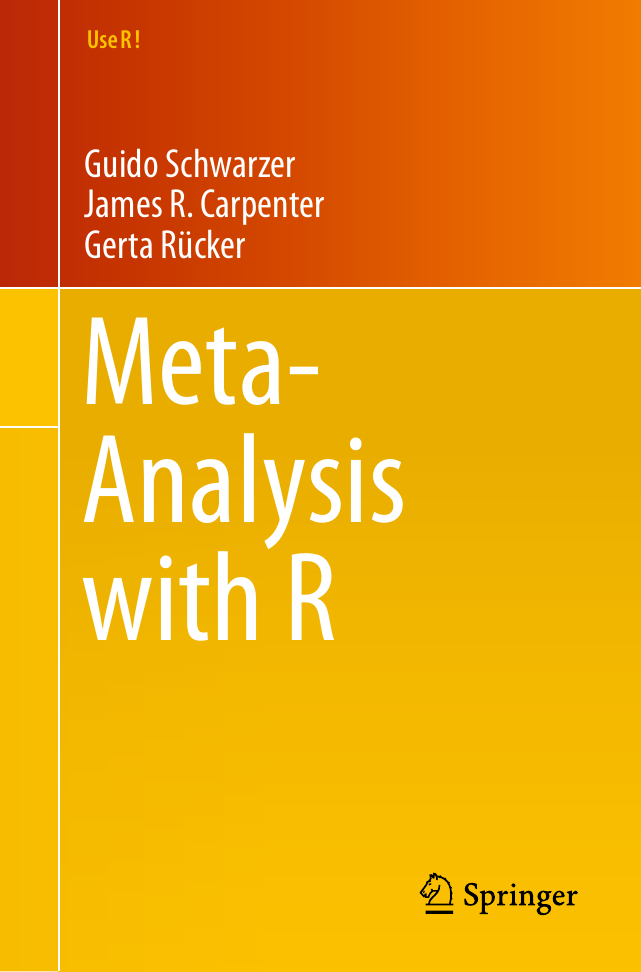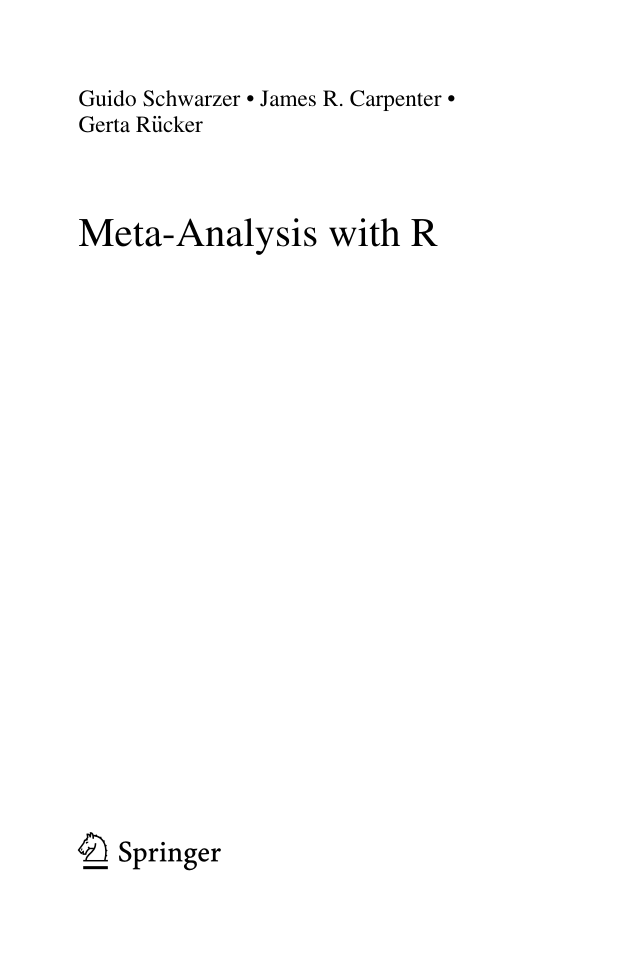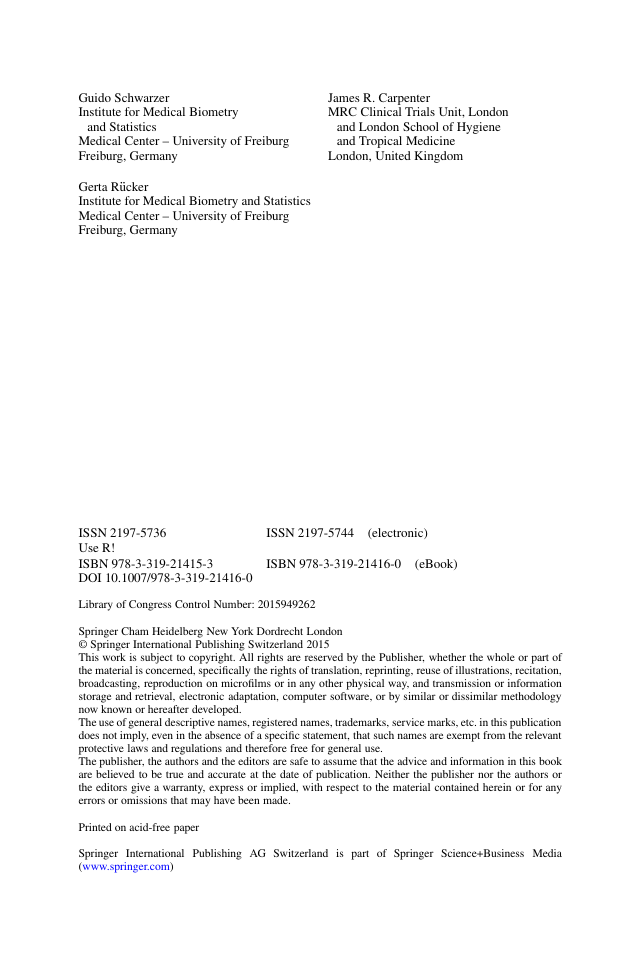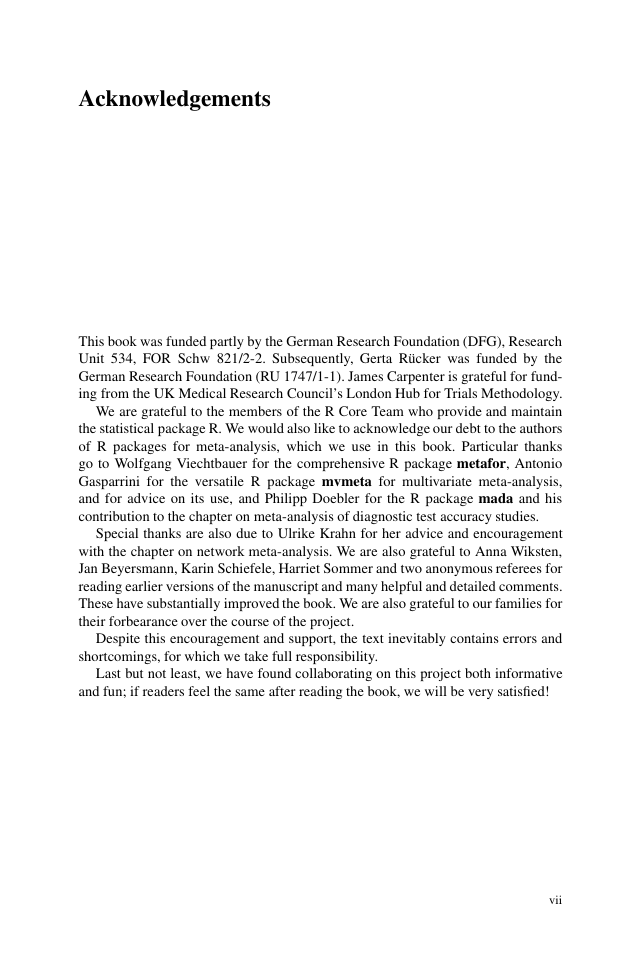Preface
Acknowledgements
Contents
Part I Getting Started
1 An Introduction to Meta-Analysis in R
1.1 Getting Started with R
1.1.1 Quitting R
1.1.2 R as a Calculator
1.1.3 Getting Help
1.2 Loading, Saving and Restoring Data
1.2.1 Importing Data from Other Packages
1.3 Select Variables from an R Dataset
1.4 Running Scripts
1.5 Installing and Using Libraries of Additional Functions
1.6 A First Meta-Analysis with R
1.7 Summary
References
Part II Standard Methods
2 Fixed Effect and Random Effects Meta-Analysis
2.1 Effect Measures for Continuous Outcomes
2.1.1 Mean Difference
2.1.2 Standardised Mean Difference
2.2 Fixed Effect Model
2.3 Random Effects Model
2.3.1 Estimation of Between-Study Variance
2.3.2 Hartung–Knapp Adjustment
2.3.3 Prediction Intervals
2.4 Tests and Measures of Heterogeneity
2.5 Subgroup Analysis
2.6 Meta-Analysis of Other Outcomes
2.6.1 Meta-Analysis with Survival Outcomes
2.6.2 Meta-Analysis of Cross-Over Trials
2.6.3 Meta-Analysis of Adjusted Treatment Effects
2.7 Summary
References
3 Meta-Analysis with Binary Outcomes
3.1 Effect Measures for Binary Outcomes
3.1.1 Odds Ratio
3.1.2 Risk Ratio
3.1.3 Risk Difference
3.1.4 Arcsine Difference
3.2 Estimation in Sparse Data
3.2.1 Peto Odds Ratio
3.3 Fixed Effect Model
3.3.1 Inverse Variance Method
3.3.2 Mantel–Haenszel Method
Odds Ratio
Risk Ratio
Risk Difference
3.3.3 Peto Method
3.4 Random Effects Model
3.4.1 DerSimonian–Laird Method
3.5 Heterogeneity and Subgroup Analyses
3.6 Summary
References
4 Heterogeneity and Meta-Regression
4.1 Sources of Heterogeneity
4.2 Measures of Heterogeneity
4.3 Test for Subgroup Differences
4.3.1 Fixed Effect Model
4.3.2 Random Effects Model with Separate Estimates of τ2
Estimate Separate Between-Study Variances (DerSimonian–Laird Method)
4.3.3 Random Effects Model with Common Estimate of τ2
Estimate Common Between-Study Variance (DerSimonian–Laird Method)
4.4 Meta-Regression
4.4.1 Meta-Regression with a Categorical Covariate
4.4.2 Meta-Regression with a Continuous Covariate
4.5 Summary
References
Part III Advanced Topics
5 Small-Study Effects in Meta-Analysis
5.1 Graphical Illustration of Small-Study Effects
5.1.1 Funnel Plot
Details on funnel.meta Function
Contour-Enhanced Funnel Plot
5.1.2 Radial Plot
5.2 Statistical Tests for Small-Study Effects
5.2.1 Classical Tests by Begg and Egger
Begg and Mazumdar Test: Rank Correlation Test
Egger's Test: Linear Regression Test
Test by Thompson and Sharp
5.2.2 Modified Versions of Classical Tests for BinaryOutcomes
Harbord's Test: Score-Based Test
Macaskill's Test and Peters' Test
Schwarzer's Test
Rücker's Tests: Tests Based on Arcsine Difference
5.3 Adjusting for Small-Study Effects
5.3.1 Trim-and-Fill Method
5.3.2 Copas Selection Model
Funnel plot (Top Left)
Contour plot (Top Right)
Treatment effect plot (Bottom Left)
P-value plot (Bottom Right)
5.3.3 Adjustment by Regression
5.4 Summary
References
6 Missing Data in Meta-Analysis
6.1 Missing Outcome Data: Some Considerations
6.1.1 Study-Level Adjustment for Missing Data
6.1.2 Sensitivity Analysis Strategies
6.1.3 Strategy 1: Fixed Equal
6.1.4 Strategy 2: Fixed Opposite
6.1.5 Strategy 3: Random Equal
6.1.6 Strategy 4: Random Uncorrelated
6.1.7 Discussion of the Four Strategies
6.2 Missing Precision
6.2.1 Multiple Imputation Approach
Basic Idea of Multiple Imputation Algorithm
Further Details
6.2.2 Missing Participant Numbers
6.3 Summary
References
7 Multivariate Meta-Analysis
7.1 Fixed Effect Model
7.2 Dealing with Unbalanced Data
7.3 Random Effects Model
7.3.1 Fitting the Random Effects Model
7.4 Discussion
References
8 Network Meta-Analysis
8.1 Concepts and Challenges of Network Meta-Analysis
8.2 Model and Estimation in Network Meta-Analysis
8.2.1 Fixed Effect Model
Estimation of Treatment Effects
Variance Estimation
Multi-Arm Studies
I-Squared for Network Meta-Analysis
8.2.2 Random Effects Model
8.3 Using the R Package netmeta for Network Meta-Analysis
8.3.1 Basic Analysis and Network Plots
8.3.2 A First Network Plot
8.3.3 A More Detailed Look at the Output
8.3.4 Additional Network Plots
8.3.5 Forest Plots
8.4 Decomposition of the Heterogeneity Statistic
8.5 The Net Heat Plot
8.5.1 Bland–Altman Plot to Assess the Effect of Heterogeneity on Estimated Treatment Comparisons
8.6 Summary
References
9 Meta-Analysis of Diagnostic Test Accuracy Studies
9.1 Special Challenges in Meta-Analysis of Diagnostic Test Accuracy Studies
9.2 Analysis of Diagnostic Test Accuracy Studies
9.2.1 Definition of Sensitivity and Specificity
9.2.2 Additional Measures: Diagnostic Odds Ratio and Likelihood Ratios
9.2.3 Tests Based on a Continuous Marker
9.3 Scatterplot of Sensitivity and Specificity
9.4 Models for Meta-Analysis of Diagnostic Test Accuracy Studies
9.4.1 Hierarchical Model
9.4.2 Bivariate Model
9.5 Methods for Estimating a Summary ROC Curve
9.6 Summary
References
A Further Information on R
A.1 Installation of R
A.2 Importing Data into R
A.2.1 Import Text Files
A.2.2 Import Data from RevMan 5
A.3 R Packages for Meta-Analysis
A.3.1 General Purpose R Packages for Meta-Analysis
A.3.2 R Packages to Conduct Network Meta-Analysis
References
Index
















 2023年江西萍乡中考道德与法治真题及答案.doc
2023年江西萍乡中考道德与法治真题及答案.doc 2012年重庆南川中考生物真题及答案.doc
2012年重庆南川中考生物真题及答案.doc 2013年江西师范大学地理学综合及文艺理论基础考研真题.doc
2013年江西师范大学地理学综合及文艺理论基础考研真题.doc 2020年四川甘孜小升初语文真题及答案I卷.doc
2020年四川甘孜小升初语文真题及答案I卷.doc 2020年注册岩土工程师专业基础考试真题及答案.doc
2020年注册岩土工程师专业基础考试真题及答案.doc 2023-2024学年福建省厦门市九年级上学期数学月考试题及答案.doc
2023-2024学年福建省厦门市九年级上学期数学月考试题及答案.doc 2021-2022学年辽宁省沈阳市大东区九年级上学期语文期末试题及答案.doc
2021-2022学年辽宁省沈阳市大东区九年级上学期语文期末试题及答案.doc 2022-2023学年北京东城区初三第一学期物理期末试卷及答案.doc
2022-2023学年北京东城区初三第一学期物理期末试卷及答案.doc 2018上半年江西教师资格初中地理学科知识与教学能力真题及答案.doc
2018上半年江西教师资格初中地理学科知识与教学能力真题及答案.doc 2012年河北国家公务员申论考试真题及答案-省级.doc
2012年河北国家公务员申论考试真题及答案-省级.doc 2020-2021学年江苏省扬州市江都区邵樊片九年级上学期数学第一次质量检测试题及答案.doc
2020-2021学年江苏省扬州市江都区邵樊片九年级上学期数学第一次质量检测试题及答案.doc 2022下半年黑龙江教师资格证中学综合素质真题及答案.doc
2022下半年黑龙江教师资格证中学综合素质真题及答案.doc